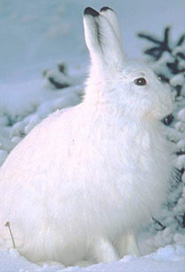 The Snowshoe Hare (Lepus americanus), an exclusively North American Lagomorph, has three to four litters in the breeding season. She can conceive again while she is already pregnant with young because of two uteri. Gestation periods average 37 days; anywhere between two and seven offspring are born. They live under brush at least one meter tall to keep themselves safe from terrestrial threat. In other areas where birds are prevalent they will seek shelter in three-meter forest understory. Fifteen meters of horizontal foliage is required for cover and warmth. Here, the young are nested in a shallow depression called a form, rather than underground. The leverets are born ready to take care of themselves in this precarious environment. They grow 17 to 25 cm in size and approximately .9 to 2 kg in weight. The underbrush also serves as a place for a "Snowshoe" to groom and to feed its young. Their habitat is generally located in the higher latitudes of the continent but if the lower latitudes such as those in Virginia and the Carolinas have the same environmental conditions at the higher elevations, the hares will live there. Preferring coniferous undergrowth in winter and deciduous in the summer, their diet consists of a variety of greenery, buds, twigs, bark and berries.
The Snowshoe Hare (Lepus americanus), an exclusively North American Lagomorph, has three to four litters in the breeding season. She can conceive again while she is already pregnant with young because of two uteri. Gestation periods average 37 days; anywhere between two and seven offspring are born. They live under brush at least one meter tall to keep themselves safe from terrestrial threat. In other areas where birds are prevalent they will seek shelter in three-meter forest understory. Fifteen meters of horizontal foliage is required for cover and warmth. Here, the young are nested in a shallow depression called a form, rather than underground. The leverets are born ready to take care of themselves in this precarious environment. They grow 17 to 25 cm in size and approximately .9 to 2 kg in weight. The underbrush also serves as a place for a "Snowshoe" to groom and to feed its young. Their habitat is generally located in the higher latitudes of the continent but if the lower latitudes such as those in Virginia and the Carolinas have the same environmental conditions at the higher elevations, the hares will live there. Preferring coniferous undergrowth in winter and deciduous in the summer, their diet consists of a variety of greenery, buds, twigs, bark and berries. The lifespan of the Snowshoe Hare living in the wild is one year. About 15 percent of the population survives five years.
Keywords: tail , camouflage , white , brown , black , hibernate
The Snowshoe hare is listed as Least Concern (LR/lc), lowest risk. Does not qualify for a more at risk category. Widespread and abundant taxa are included in this category, on the IUCN Red List of Threatened Species
Namings for the snowshoe hare
A young / baby of a snowshoe hare is called a 'leveret'. The females are called 'doe or jill' and males 'buck or jack'. A snowshoe hare group is called a 'band or down'.Snowshoe hare habitats
Subarctic forestSome facts about the
Snowshoe rabbit
Adult weight : 1.6 kg (3.52 lbs)
Female maturity :308 days
Male maturity : 411 days
Gestation : 36 days
Weaning : 20 days
Litter size : 3
Litters per year : 3
Interval between litters : 39 days
Weight at birth : 0.061 kg (0.1342 lbs)
Weight at weaning : 0.362 kg (0.7964 lbs)
Basal metabolic rate : 7 W
Body mass : 1.603 kg (3.5266 lbs)
Temperature : 39.85 °C (103.73 °F)

Custom Search